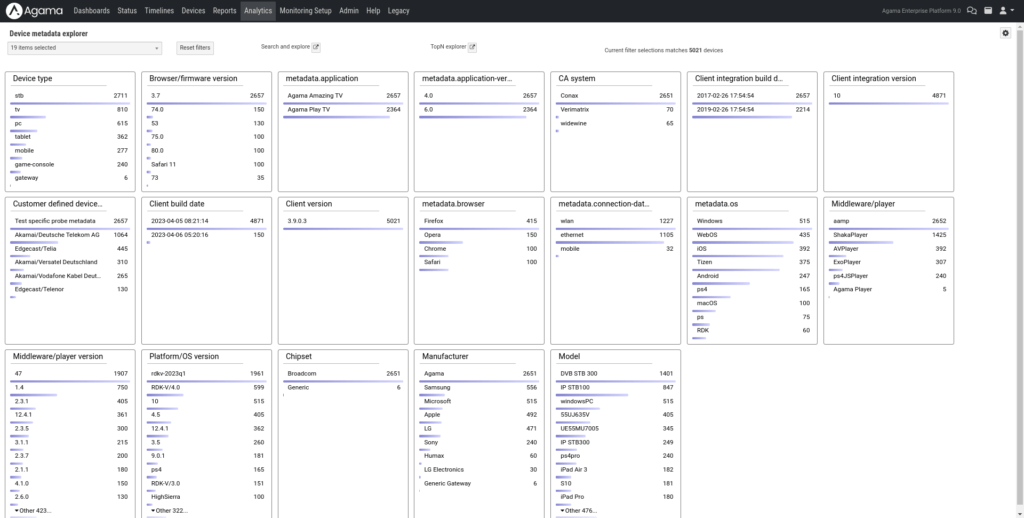Collecting video performance telemetry from a range of apps and set-top boxes may be challenging, especially when analyzing and comparing the data. To evaluate this data effectively, a key factor is to ensure that the data uses a consistent naming for the metadata and that metrics are comparable.
By achieving consistency in these areas, it becomes easier to compile and compare the performance of data across platforms, which in turn helps identify areas for improvement and optimize the overall viewer experience.
Correlating service performance with usage on different platforms
Typically, telemetry plugins are used to ensure that metrics’ names relate to the same underlying metrics, where the mapping between standardized metric names and player events is already done. For environments that are more complex, this is done during the integration project and subsequent validation.
When it comes to metadata, one of the most important data is the names of the channels and assets. This data includes the live/VOD specification, the name of the channel, the VOD asset name, and the name of the service to which the asset belongs to.
Without consistency here, it becomes difficult or impossible to correlate the service performance and usage between various platforms. One of the reasons for this is that different platforms can use different sources of ground truth in terms of the naming of channels, apps names, or version names.
Another reason is that simple little errors during instrumentation such as writing “Channel A” instead of “Channel a” often leads to different names.
Agama Metadata Explorer
Of course, ensuring that naming is correct already at the source is something that one should strive for. We provide several tools such as our “Metadata Explorer” app, to make it as fast and easy as possible to determine the metadata that is being used by various apps, devices, and integration versions.
The metadata explorer is a separate application where the reported metadata from all devices is visualized – the histogram shows the distribution of the values for every metadata field. By clicking on a specific value, such as a specific software version, all metadata is updated to show just the data from those devices. This allows for quick validation that metadata is correct for new versions of Apps and devices.
Nevertheless, even in the best of worlds, mistakes and integration differences will always exist. For this reason, we provide a comprehensive set of backend processing tools that standardize channel- and asset names.
Data washing is a must for complex deployments
When the video is consumed, the backend continuously receives metric and event data from the app or device. This data includes the URI and optional metadata, such as an asset name, whether it is VOD or live, and other information. In the case that one wants to correct missing or incorrect channel names, a rule-based system can be enabled. It allows you to define rules that will match a URI to extract a relevant part of it. This will naturally vary from one deployment to another. The extracted identifier is then mapped to the actual channel name.
Multiple naming schemes can be supported concurrently by supporting various rule sets that can be applied in order of priority and per type of service.
With the channel name now corrected, it can be correlated and analyzed in the Agama system, used as the basis for Content Engagement Analytics, or used in an external data lake, regardless of the app used initially.
In a complex deployment scenario, data washing is a must in order to support a data-driven way of working.
Conclusion
In general, the app and device data analysis require data cleaning. Whether you’re dealing with metadata or more complex data types, it is essential to ensure that the information is correct, complete, and consistent.
This article’s recommended Metadata Explorer app offers features that make metadata management more efficient, allowing users to verify that naming and metrics remain consistent. Keep in mind that data cleaning is a continuous activity that should be conducted on a regular basis to maintain maximum efficiency, reduce mistakes, and optimize the value of your data.
About Johan Görsjö
Johan leads the Product and Development, responsible for revolutionizing Agama’s products and solutions. He works with Product Strategy and closely with Sales and Marketing.
Johan has over 20 years of experience in the Telecom and Video industry.


